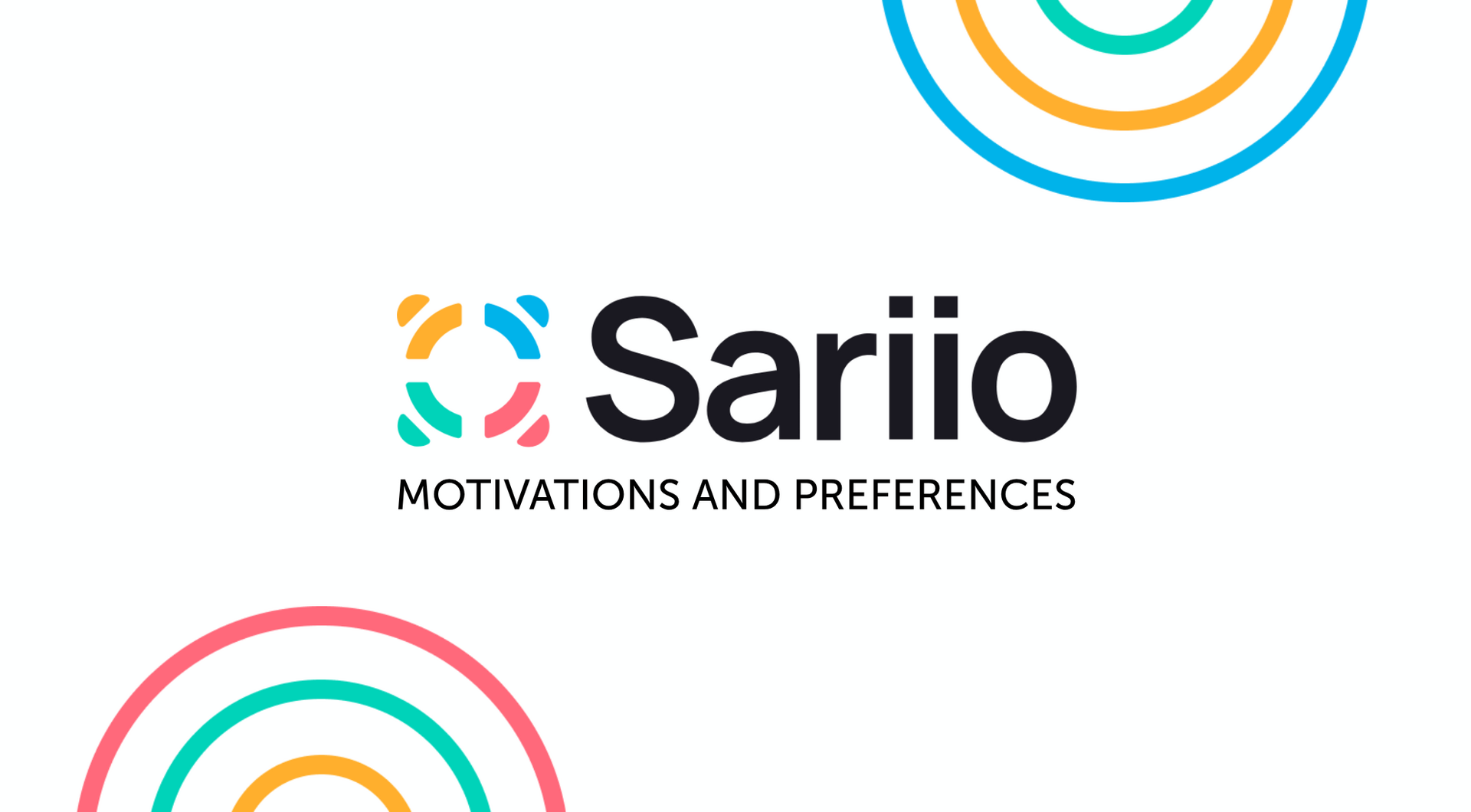Introduction to the Sariio MAPS archetypes
Sariio MAPS shows how twelve professional archetypes shape communication, thinking, decision-making behaviour and implementation in everyday working life. The analysis provides clear strength profiles, pointers to potential stumbling blocks and concrete coaching ideas – for better collaboration, more productive meetings and stronger results.
Sariio MAPS is an evidence-based framework that does not divide people into rigid personality types. Instead, it uses metaprogrammes – recurring patterns of thinking and behaviour that professionals can consciously control and develop.
The approach is practical: individuals and teams should make targeted use of their strengths, identify risks earlier and measurably improve their collaboration.
Each of the four factors comprises three archetypes (twelve in total):
- Connecting: Cautious • Diplomatic • Inclusive
- Thinking: Methodical • Agile • Innovative
- Deciding: Analytical • Balanced • Decisive
- Implementing: Thorough • Pragmatic • Motivated
The central archetype of each factor is an adaptive blend of two extremes. Example:
Agile balances structure and flexibility, Pragmatic combines speed with sufficient depth.
Professionals usually display a primary pattern with room for manoeuvre – influenced by context, stakes and pressure.
Archetypes explained
Connecting archetypes
Cautious (Connecting)
Essence: Observant, selective and cautious in building trust.
What stands out in everyday work:
- Building relationships step by step
- Precise scanning of signals, tone, reliability
- High need for clear roles and expectations
Strengths
- Early recognition of interpersonal risks
- Deep, resilient relationships
- Calm and stability in sensitive situations
Challenges
- Appears distant at first
- Opportunities for quick exchanges may be missed
How to work effectively with cautious people
- Clear agendas, opportunities for preparation, reliability
- Ask for assessments early on – especially when there are reputational risks
Coaching tip
Consciously share additional information in important meetings to build trust in a controlled manner.
Diplomatic (connecting)
Essence: Connects perspectives, creates common ground and keeps conversations constructive.
What stands out:
- Very good listening & reading the mood
- Neutral, de-escalating communication
- Focus on win-win solutions
Strengths:
- Conflict defusing
- Coalition building
- High communicative and cultural flexibility
Challenges:
- Risk of over-adaptation
- Seeking consensus can delay decisions
Effective collaboration:
- Set clear decision-making boundaries and time frames
- Request a summary of the results at the end of a meeting
Coaching tip:
Practise ‘friendly directness’ – combine every concession with a clear request.
Inclusive (connecting)
Essence: Builds trust, promotes belonging and strengthens team spirit.
What stands out:
- Actively draws in quiet voices
- Connects teams and ideas across the organisation
- Focuses on positive, relationship-oriented communication
Strengths:
- Strong catalyst for team culture
- High quality of creative solutions
- Excellent at onboarding & integration
Challenges:
- Risk of overload
- Conflicts are sometimes avoided
Tips for collaboration:
- Clarify priorities, capacities & boundaries
- Ideal for team rituals & cultural work
Coaching tip:
‘Two-pronged agenda’: first nurture relationships, then make decisions.
Thinking archetypes
Methodical (thinking)
Essence: Structured planners with a focus on process reliability and reproducibility.
What stands out:
- Love of checklists and SOPs
- High risk sensitivity
- Scalable process design
Strengths:
- Reliable implementation
- Error prevention
- Stability across teams & cycles
Challenges:
- Rigidity when faced with new requirements
- Slower iteration
Effective collaboration:
Define common basic processes, make exceptions explicit.
Coaching tip:
Incorporate small pilot steps before the final plan.
Agile (thinking)
Essence: Finds the balance between structure and adaptability.
What stands out:
- Flexible in dealing with rules
- Short test-learn loops
- Just-enough processes
Strengths:
- Resilience in uncertainty
- Pragmatism
- Mediator between rigid and risk-taking ways of working
Challenges:
- Danger of becoming a general problem solver
- Too many options can create uncertainty
Collaboration:
Results-oriented goals, short planning horizons, visibility (e.g. Kanban).
Coaching tip:
Actively limit parallel projects.
Innovative (thinking)
Essence: Creative explorers with an eye for opportunities and the future.
What stands out:
- Strong creative divergence
- Focus on potential rather than limitations
- Rules as tools, not obstacles
Strengths:
- Breakthroughs & new values
- Early recognition of trends
- Inspiring energy
Challenges:
- Ideas > Implementation
- Stakeholders overwhelmed by too many changes
Collaboration:
Limit exploration phases, define clear criteria, pair with thorough partners.
Coaching tip:
‘Kill list’ for prioritising ideas.
Deciding archetypes
Analytical (Deciding)
Essence: Makes decisions based on facts, logically and in a structured manner.
What stands out in everyday work:
- Develops hypotheses, actively searches for data points and evidence
- Presents risks, assumptions and probabilities transparently
- Documents decisions in a comprehensible and consistent manner
Strengths
- High quality of assessment and argumentation
- Ability to organise complexity and think strategically
- Sets standards for clarity and transparency in teams
Challenges
- Can fall into ‘analysis paralysis’ when faced with uncertainty
- Tends to underestimate intuition
- Can overlook indirect signals (mood, dynamics)
Collaboration
- Provide clean data, clear criteria and time for evaluation
- For situations where speed counts: ask for the ‘minimum viable decision’
Coaching tip
Test the 70/30 rule: act when 70% of the information is available and view the remaining 30% as learning material.
Balanced (Deciding)
Essence: Uses logic and intuition equally and finds situational solutions.
What stands out:
- Connects data points with experience and gut feeling
- Adapts rigour and level of analysis to stakes and context
- Set decision deadlines to avoid loops
Strengths:
- High context sensitivity
- Good balance between speed and quality
- Models decision-making processes that others can adopt
Challenges:
- Can be perceived as indecisive
- Often asked to resolve conflicts
- Needs to communicate boundaries more clearly
Collaboration:
- Define dominant dimensions: risk, speed, cost, quality
- Define escalation path before project start
Coaching tip:
Agree on clear ‘stop rules’ – when is enough analysis done and a decision necessary?
Decisive (Deciding)
Essence: Action-oriented, makes decisions quickly and despite incomplete information.
What stands out:
- Quickly evaluates signals and filters out noise
- Values momentum and progress more than perfection
- Takes responsibility and continuously adapts decisions
Strengths:
- Sets the pace, prevents drift
- Very effective in crises or under time pressure
- High willingness to learn through rapid feedback loops
Challenges:
- Risk of overlooking critical details
- May irritate stakeholders with directness
- Danger of over-optimism
Collaboration
- Provide precise options with clear compromises
- Define in advance which decisions are reversible and which are not
Coaching tip
Introduce short debriefings – not for control, but as quick learning loops that do not slow down the pace.
Implementing archetypes
Thorough (implementing)
Essence: Precise, detail-oriented, quality-conscious – ensures reliable results.
What stands out:
- High standards, clear requirements, meticulous checklists
- Focus on causes rather than symptoms
- Careful documentation for long-term traceability
Strengths:
- Minimises risk and errors
- Delivers reliably, with few surprises
- Raises quality standards in the team
Challenges
- Perfection can slow down speed
- Frequent changes are frustrating and cause a lot of effort
Collaboration
- Define scope early on, limit changes
- Schedule formal reviews and QA gates
Coaching tip
Define a ‘good enough’ limit: What quality is required now – and what is optional?
Pragmatic (implementing)
Essence: Results-oriented, quickly finds practical solutions and keeps projects moving.
What stands out:
- Focus on outcomes rather than strict plans
- Adjusts depth and diligence according to value & risk
- High resourcefulness with limited resources
Strengths
- Enormous versatility
- Efficiency through elimination of ballast
- Builds trust through transparent, comprehensible decisions.
Challenges
- Invisible work is often underestimated
- Scope creep due to quick helpfulness.
Collaboration
- Clearly define results and limits
- Document pragmatic compromises.
Coaching tip
Regularly use ‘Stop – Start – Continue’ to maintain focus and priority.
Motivated / Driven (Implementing)
Essence: Action-oriented, fast, energetic – makes things happen.
What stands out:
- Prefers fast cycles and visible progress
- Quickly removes obstacles
- Focuses on the big picture, not on details
Strengths
- Creates momentum and prevents stagnation
- Motivates teams to achieve ambitious goals
- Delivers results under pressure
Challenges
- Risk of compromising on quality
- Low attention to detail and documentation
- Pace can overwhelm others
Collaboration
- Clear goals, lots of autonomy, quick feedback
- For balance: pair with thorough people
Coaching tip
Introduce ‘time-limited quality checks’ – short stops to avoid mistakes without losing momentum.
Working with combinations
Sariio MAPS only unleashes its power when archetypes are combined. Each person brings a unique blend of connection, thinking, decision-making and implementation styles.
Polarisation often becomes apparent under pressure:
Exemplary dynamics under stress
Cautious • Methodical • Analytical • Pragmatic → Tendency to be thorough
→ Focus on accuracy, risk minimisation, resistance to scope changes
Diplomatic • Agile • Determined • Pragmatic → Tendency to be motivated/driven
→ Cycles become shorter, risk increases, focus on delivery over perfection
Professionals can consciously use these patterns:
- Calculate expected stress reactions in advance
- Pair roles (e.g. innovative + thorough)
- Define stop rules and escalation paths in advance
This creates teams that deliver faster, better and with less friction.
Practical applications for managers and teams
1. Recruiting & role matching
Use archetypes specifically for role requirements:
- Thorough for compliance or risk-sensitive areas
- Motivated/driven for turnarounds or sales cycles
- Methodical for process and scaling projects
2. Team design & collaboration
- Consciously combine opposites and the middle ground
- Example: Innovative + Methodical results in ideas that are actually implemented
3. Strengthen decision-making quality
- Analytical people formulate options
- Decisive people make decisions under pressure
- Balanced people define thresholds for mode changes
4. Meetings, rituals and rhythm
- Motivated/Decisive: short stand-ups, quick iterations
- Thorough/analytical: structured reviews and QA cycles
5. Coaching & development
- Cautious: safe spaces for experimentation
- Inclusive: strengthening conflict management skills
- Methodical: small tests instead of major redesigns
- Innovative: consciously reducing and prioritising ideas
In this context, professional work means flexibility through awareness of one's own patterns.
Conclusion
The twelve archetypes are lenses, not labels.
They help professionals recognise important patterns, communicate more effectively and make better decisions – faster, clearer and with less friction.
Sariio MAPS creates a common language that helps teams and leaders leverage diversity productively and turn individual preferences into a real strategic advantage.



